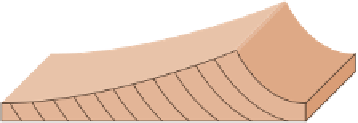Geology Reference
In-Depth Information
◗
Figure 15.7
Sand Dunes Large sand dunes in Death Valley, California. The prevailing wind direction
is from left to right, as indicated by the sand dunes in which the gentle windward side is on the left
and the steeper leeward slope is on the right.
leeward slope, the dune slowly migrates in the direction of
the prevailing wind (Figure 15.8b). When preserved in the
geologic record, dunes help geologists determine the prevail-
ing direction of ancient winds (
dunes result from the interaction of such factors as sand
supply, the direction and velocity of the prevailing wind,
and the amount of vegetation. Although dunes are usually
found in deserts, they can also develop wherever sand is
abundant, such as along the upper parts of many beaches.
Barchan dunes
are crescent-shaped dunes whose
tips point downwind (
◗
Figure 15.9).
Geologists recognize four major dune types (barchan, lon-
gitudinal, transverse, and parabolic), although intermedi-
ate forms also exist. The size, shape, and arrangement of
◗
Figure 15.10). They form in areas
that have a generally flat, dry surface with little vegeta-
tion, a limited supply of sand, and a nearly constant wind
◗
Figure 15.8
Dune Migration
Wind
Wind
Direction of
dune migration
Sand moves by saltation
Leeward
slope
Leeward
Leeward
slope
Windward
side
Windward
Windward
side
a
Profi le of a sand dune.
b
Dunes migrate when sand moves up the windward side and slides down the
leeward slope. Such movement of the sand grains produces a series of cross-
beds that slope in the direction of wind movement.















































































































































































































































































































































































































































































































































































































































































































































































































































































































































































































































































































































































































































































































































































































































































































Search WWH ::

Custom Search